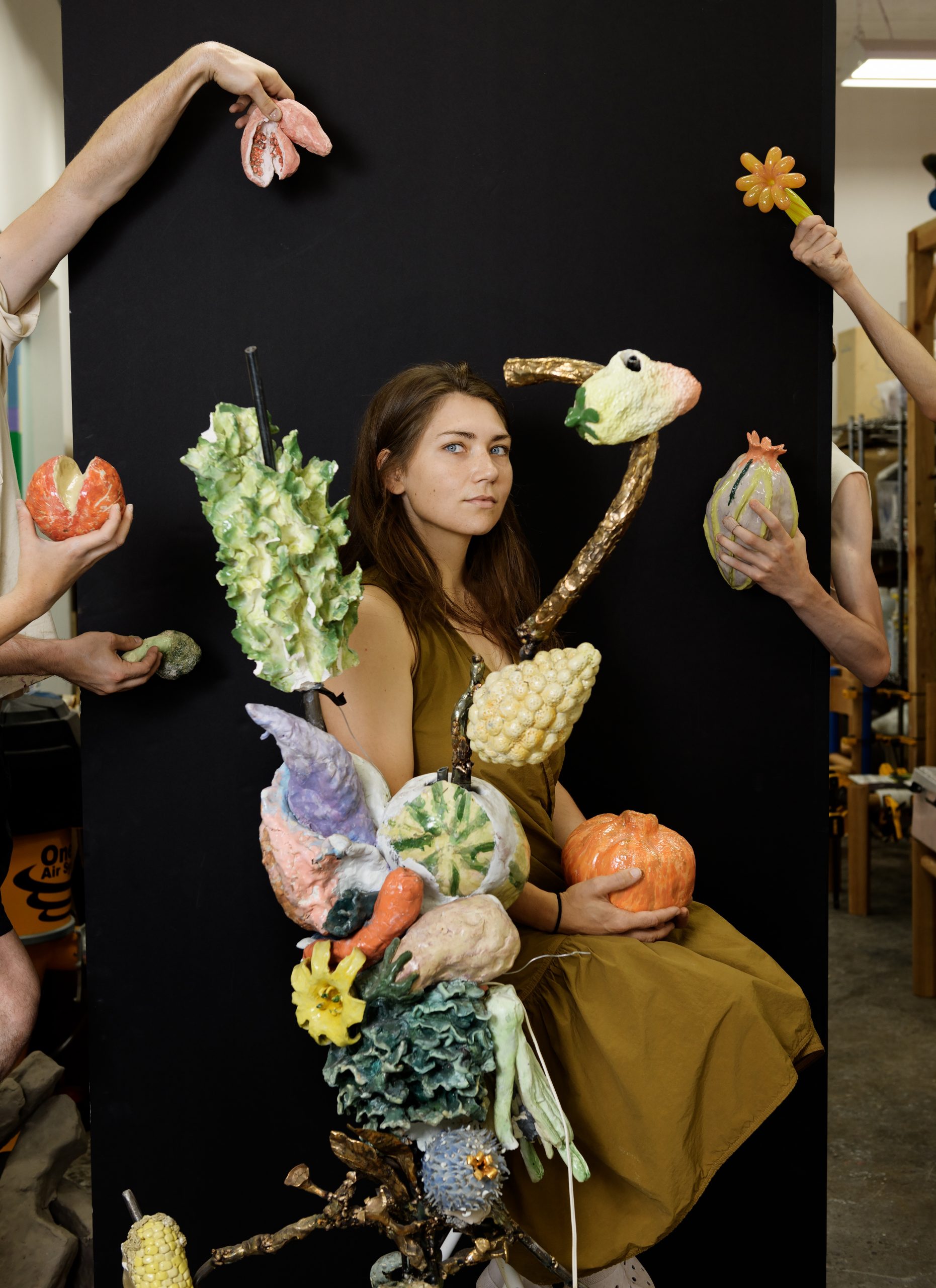
From her ceramic “Lady Lamps” (cartoonish clay women, nude and sometimes appearing to be made of fruit, holding lampshades over their heads) to her purely ornamental, bronze-bezeled “Wall Jewelry,” Katie Stout’s practice straddles functional design and abstract sculpture. She deftly references sources as disparate as Victorian lace patterns and suburban kitsch, all while subverting expectations of form, function, and traditionally female craft techniques—and with humor.
“Walking the line between beauty and vulgarity feels so good,” the Maine-born, 30-something artist and designer recently told the New York Times. Her work—which is in the permanent collections of the Dallas Museum of Art, New York’s Museum of Arts and Design, and the San Francisco Museum of Modern Art—is candy-colored and uncannily playful. It also pointedly critiques the many stereotypes that still govern how women work, look, and live.
Not Stout, though. This spring, she and her husband left Brooklyn to make an early 20th-century church and parsonage in Hudson, New York, their home. She’s turning the church into her studio—a big work in progress, in service of her many works in progress—complete with a bell tower and a graveyard and windows of stained glass. “The space,” she said, “provides a lot of opportunity for world building.”
While preparing new works in clay for group shows in Paris (with Nina Johnson Gallery this October) and at the Montreal Museum of Fine Arts (with “Designed by Women,” next year), the artist-designer gave Artnet News a sneak peek inside.
A pendant light fixture crafted in ceramic by Katie Stout, 2021. Photo: Joe Kramm.
What is a studio task on your agenda this week that you are most looking forward to?
Smushing wax for some bronze chandeliers.
What kind of atmosphere do you prefer when you work? Do you listen to music or podcasts, or do you prefer silence? Why?
I love listening to mind-numbing pop to get me out of my body—anything anthemic works.
Can you send us a snap of the most indispensable item(s) in your studio and tell us why you can’t live without it?
Couldn’t decide between finger or credit card!
Courtesy of Katie Stout.
Who are your favorite artists, curators, or other thinkers to follow on social media right now?
As far as social media goes, I’ve turned into a Reddit voyeur, so I mostly just follow randos posting stuff. But I have loved Alissa Bennett ever since meeting her through Bjarne Melgaard. Before her podcast The C-Word, which j’adore, she had these amazing zines that felt like love letters to women who everyone else hated.
What trait do you most admire in a work of art? What trait do you most despise?
I think craft, and craft.
Is there a picture you can send of your current work in progress at the studio?
Yes:
Courtesy of Katie Stout.
When you feel stuck while preparing for a show, what do you do to get unstuck?
I go on runs, get eight hours a sleep, refrain from sugar 🙂 Or, I usually just spiral ’til it’s over.
What is the last exhibition you saw that made an impression on you and why?
Taylor Baldwin and Serra Victoria Bothwell Fels, “Honest Bodies” at International Waters in Brooklyn this past winter. The space and the work complimented each other so well; both were so weird and uncanny. International Waters is basically just a room on a slant, so you’re looking up into it. Serra’s work messed with your perception even more with these bloated drop-ceiling pieces, and Taylor’s work, if shown in a different context, could have been perceived as obsessive yard art. That being-on-the-brink energy is something I respond to. The whole thing was so delirious and beautiful and the use of material was novel and heartfelt.
What images or objects do you look at while you work? Share your view from behind the canvas or your desktop—wherever you spend the most time.
Right now I stare at stained-glass windows.
Inside Stout’s new, under-construction studio in Hudson, New York. Courtesy of Katie Stout.
What made you choose this particular studio over others?
My husband and I bought a church and parsonage upstate, and I’m building out the church to be my studio. The space clicks with us and provides a lot of opportunity for world building.
Describe the space in three adjectives.
Apple, horse, bird.
How does the studio environment influence the way you work?
Right now it’s very dim because of the stained glass and a shortage of electricians, but I’m actually kind of liking not being able to see. There’s less to scrutinize if you can’t see it, which is very freeing.